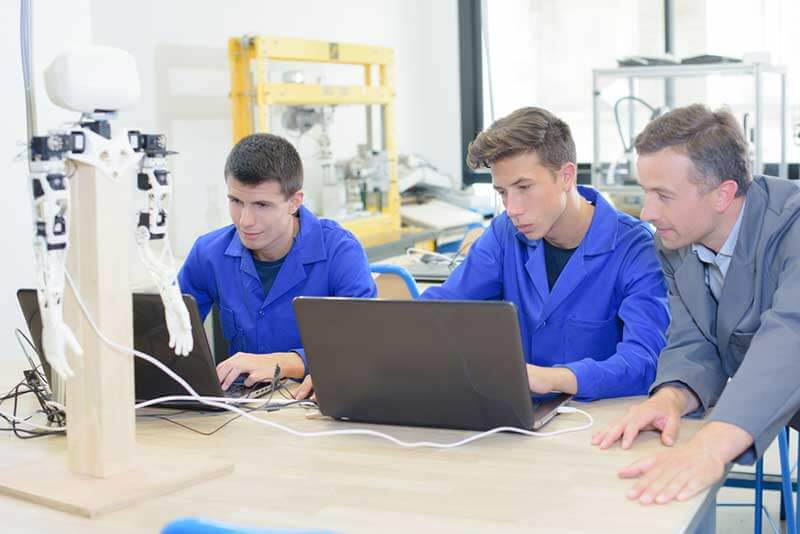- Robots can function as stand-ins for students – or teachers
- NAO is helping students with autism to learn social skills
- Robotics can turn student excitement into a passion for learning
- Learning about robots and robotics should start at primary school
- Robots in education are here. And they aren’t going anywhere
Not so very long ago, the idea of having robots in our children’s classrooms may have seemed farfetched – a future many of us never thought we’d see. That future is now closer than ever. In fact, it has already arrived at various schools around the world, with teachers starting to experiment with ways in which robots can add value to their teaching methods. Combined with specific curriculums and different types of software, robots and robotics can offer a host of fascinating new educational opportunities.
Robots can function as stand-ins for students – or teachers
Students with serious or terminal diseases often aren’t able to attend regular classes. This means that they not only miss out on lessons but on social interactions with their classmates as well. Robots can help solve these challenges by acting as stand-ins for the students, so that they are able to attend school from anywhere in the world. One telepresence robot used for this purpose is the VGo. With this robot, the sick child can basically represent himself in a different location from where he is and move around as if he were actually physically present, allowing him to continue attending classes. Because the VGo is remote controlled, it enables the sick student to move, talk, hear, see and interact independently, without any input of help from the children in the classroom. The VGo could be described as a personal avatar, a presence that embodies the remote person. Because the telepresence robot comes with a rather hefty price tag of around $6,000, it is unfortunately only available to the fortunate few. Over time, with wider adoption of the technology, the price will eventually come down so that it is accessible to a larger group of patients.
Of course, the same telepresence robots can also act as stand-ins for teachers. This enables them to teach a class from anywhere in the world, increasing the options for distance learning. With the use of telepresence robots, students living in remote parts of the world where it’s difficult to find qualified teachers will still be able to get good quality education.

NAO is helping students with autism to learn social skills
Autistic students are often confused or even intimidated by communicating with other people. Non-verbal cues and facial expressions that other people automatically pick up on, can be very difficult to comprehend for an autistic person. One robot that has been particularly useful in educating autistic children is the NAO. This fully programmable robot is multi-interactive, predictable, engaging and tireless. It has been assisting autistic children with tailor-made lessons as well as social cues and helps build bridges between the children and the people around them. NAO keeps the risk of overstimulation to a minimum and does not confuse the students with complex facial expressions or body language. He helps reduce anxiety and is easy to understand. Offering continuous encouragement and tirelessly repeating instructions, NAO easily gains a child’s trust. The robot can teach reading and writing skills as well as many other subjects such as science, technology, engineering, math, programming, geometry and art. Whether via voice, vision or touch, NAO offers a wide range of possible interactions and fun, educational applications specifically written to meet the needs of autistic children. NAO’s easy to use interface enables teachers and parents to exchange and update information and create tailor-made sessions for each individual child. The NAO also offers tools for performance analysis, recording data and creating graphs in order to keep track of the children’s progress.
Robotics can turn student excitement into a passion for learning
Tell me – and I will forget
Show me – and I may remember
Involve me – and I will understand
Chinese proverb
Teachers are hoping that student excitement about robots can turn into a passion for learning how to program. The fact that robot applications constantly change and evolve and that it’s basically a platform for educators and students to manipulate, means that students are not very likely to ever get tired of them. Robots are a powerful educational tool and children who work with them quickly develop computational thinking; the ability to break a problem up into smaller sections. Children learn by doing and hands-on activities such as designing, building, programming (even if they don’t write any code) and then watching their creation come alive is what keeps them engaged.
With robotics’ open-ended challenges, students learn project management, troubleshooting and problem analysis. Robotics classes focus on building and strengthening cognitive development, computer science and fundamental mechanical engineering concepts and the students learn strategic and goal-oriented thinking, communication skills, math and other academic subjects. They actively become involved in their own learning processes and engage in complex, strategic problem solving. They apply computational thinking and higher-order thinking, which are critical skills in engineering and science fields and other professional areas that will be in high demand in the next decade.
The benefits of learning science, technology, engineering and math (STEM) spread through each area of life, and every career choice. They teach the thinking skills that young adults in the 21st century, in a world where e-v-e-r-y-t-h-i-n-g will be affected by robotics, can’t do without. Students who are not exposed to the educational concept of robotics will have a distinct disadvantage.
Susan Wojcicki, Google’s Senior Vice President, explains, “Learning to code makes children feel confident, creative and empowered. If we want them to retain these traits into adulthood, it’s important to expose them to computer programming from an early age.”
Learning about robots and robotics should start at primary school
According to an Australian education researcher, it is never too early to start learning about robots and programming. It’s important to get them interested young, even 4-year olds are able to learn the basics. With the demand for programmers in a multitude of industries expected to increase, the next ten years will be critical for children learning computer programming. Christina Chalmers from the QUT (Queensland University of Technology in Australia) is an authority on the application of robotics at schools. She emphasises the importance of children learning these skills early in life, and that it is critical to make it fun for them. She said that the earlier schools can start their children on computer programming, the more likely they are to enjoy it at a later stage. Research has indicated that if children don’t form positive attitudes towards science, technology, engineering and math in the early years of their lives, they often find it complex to engage with STEM later on. As part of an Australian study, two schools received NAO robots, and compulsory robotics and coding classes were included in primary and secondary schools in Queensland. Early findings from the study indicated that even preschool learners managed to make drawings of their robot classmates that explained how the robot receives its coded messages. This showed complex conceptual thinking abilities as to how the behaviour of the robot was controlled.
Robots in education are here. And they aren’t going anywhere
Based on how much education has changed in the last couple of years, it’s safe to say that we really have no idea what it will look like five to ten years from now. What we can predict is that a lot of the technology that is slowly seeping into today’s classrooms will soon start playing more prominent roles in everyday education. As we are getting used to doing more and more things online, distance learning is another aspect of education that we can expect to see become more prominent in the future. The transition to taking online classes taught by an educator on the other side of the world will become a natural one. This transition will be helped along by robots and robotics, giving the increasingly remote and digital classroom a somewhat ‘human’ face – albeit in the form of a tablet moving around in a remote-controlled frame on wheels.
Robots are still quite a way away from being implemented in schools autonomously – and this is due to technological limitations such as emotion recognition and speech challenges. The ultimate goal is also not for the robot to replace the human teacher but rather to function as an assistant, adding value by providing an engaging and stimulating educational tool. The objective of technology should always be to increase the availability of the educator so that he can engage more with his learners. We need to keep looking to technology as an extension of human capabilities and remember that teaching humans still requires the human touch.





